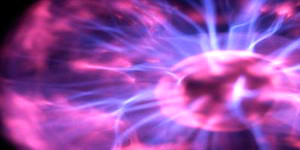Our body is built with biological tissue. The tissue that can generate or detect bioelectrical signals is called excitable tissue. Some examples of this tissue (and its cells) are: neurons and muscular tissue. Neurons are responsible of transmitting the excitatory bioelectrical signal to another neuron (forming nerves) or to a muscle tissue, gland or brain, while muscular cells are responsible of muscular contraction and distension. Some specialized cells generate bioelectric signals: optic receptors (eyes), muscular cells that transmit the feeling of pain, etc.Bioelectricity concerns the magnetic and electrical fields produced by organisms or cells.
1. The neuron
The neuron can be divided in three main parts: Dendrites, Soma, Axon (Figure 1). Dendrites are prolongations of the soma in shape of trees (dendros in Greek) and they receive most of the excitatory signals. The soma contains the nucleus of the cell and is where most of the proteinic synthesis occurs. The Axon is a prolongation of the soma and is responsible of the synapse (mechanism of transmit in the excitatory signal to another cell).
Most of vertebrates receive electrochemical stimulation in the soma or dendrites and transmit it through the axon. This bioelectrical potential involves ionic movement through cell membrane.
2. Ionic equilibrium and ionic currents
The first thing to bare in mind is that ionic concentration inside and outside the neuron is not symmetric. This leads to a concentration gradient and furthermore electric gradient. This means that there is an equilibrium voltage different between the intra-cellular medium and extra-cellular medium, for each kind of existing ion. There are four main ions involved in this process: Sodium (Na), Potassium (K), Chlorine (Cl) and Calcium (Ca). Each of them has different permitivity (equivalent to conductance) through soma membrane and different equilibrium potential. This leads to the existence of a global equilibrium potential that is called Resting Potential. In most neurons the resting potential has a negative value of about -70mV, which by convention means that there is excess negative charge in the intra-cellular medium. This value is obtained using the Nernst equation and Hodgkin-Katz-Goldman equation. The existence of different equilibrium potentials (constant) and varying permitivities let us model the neuron membrane as an electrical circuit as shown in the picture 2. CM is the capacitance of the neuron where the membrane is the dielectric.
Ion permitivity is held by the so-called ion channels which are specific for each Ion. These channels open and close during the reception, generation and transmission of the excitatory signal. The variation of these permitivities are modeled as variations in the conductances Gi. Note that GL refferes to the parallel model for Chlorine and Calcium. As can be calculated, this variations lead to variation in the equilibrium voltage and therefore transmembrane potential changes. Here we have the origin of bioelectrical signals, which can be measured with special electrodes.
3. The action potential
Action Potential is the name that identifies the excitatory signal. The reason it has this name is simple: neurons basically are binary signals transmitters/generators. Action Potentials have a specific waveform and can be considered as a logical ‘1'. When the membrane receives a stimulus (electrical or chemical signal) that makes it rise the voltage more than +20 mV (leaving the neuron at -50 mV), Action Potential (AP) is started. Action Potential has a ~+90 mV peak-to-peak voltage and can be compared to a . This AP is transmitted through the Axon (each part of the Axon membrane is excitated with the preceding AP voltage) and when reaching the Axon terminal some chemical products are ejected (neurotransmitters) which chemically stimulate the leading neuron starting the whole process in that neuron (Figure 3).
4. Bioelectric signals
All these signals sum through the body which is conductive and can be measured in the skin of a patient. For example, if we connect an electrode above a muscle and another electrode far enough in the body, we can be sensing the so-called Electromyography (myo=muscle). We will be able to see in an oscilloscope how the signal changes when we contract the muscle, extend it, etc. Two of the most interesting circuits one could build are: an ECG (Electrocardiograph) and ENG (Electronystagmograph). The first one is the known medical device that let us record the heart's activity. The ENG is a circuit that allow us trace the movement of our eyes (nystagmus). This circuitry is not complex but very useful in lots of applications. The ECG is generated due to the muscular activity of the heart. These bioelectric signals sum and generates a signal which wave is widely known. The ECG signal has a bandwidth of 150 Hz. With a lower cut-off frequency of 0.25 Hz in order to filter DC and respiration noise. ECG signals in the skin are about 5 mV of amplitude. The picture in figure 4 shows a typical ECG acquisition circuit.
The right-leg circuit is intended to reduce common mode signals which can be generated due to EMI, 110V AC coupling, etc. To avoid harmful electroshock, impedance to RL from differential stage should me about M-Ohm. The rest is a simple instrumentation amplifier with band pass filtering. Since we would like Vout to be around 5 V peak, the circuit should amplify x1000. It is recommended that the differential stage would amplify x100 and the second stage x10, in order to maximize SNR. For avoiding EMI, Faraday's cage would be advisable. Notice that C1//R9 should equal C2//R10, R4=R5, R6>1 MOhm and R7=R8. ENG voltages are about 10 mV. ENG's bandwidth is 0.05 Hz (to eliminate DC) to 5 Hz. The amplifier used is again the same as ECG but for cut-off frequencies. The connection would be: RA to right temple, LA to left temple and RL to the middle of the forehead.
For More Details : Understanding bioelectricity


